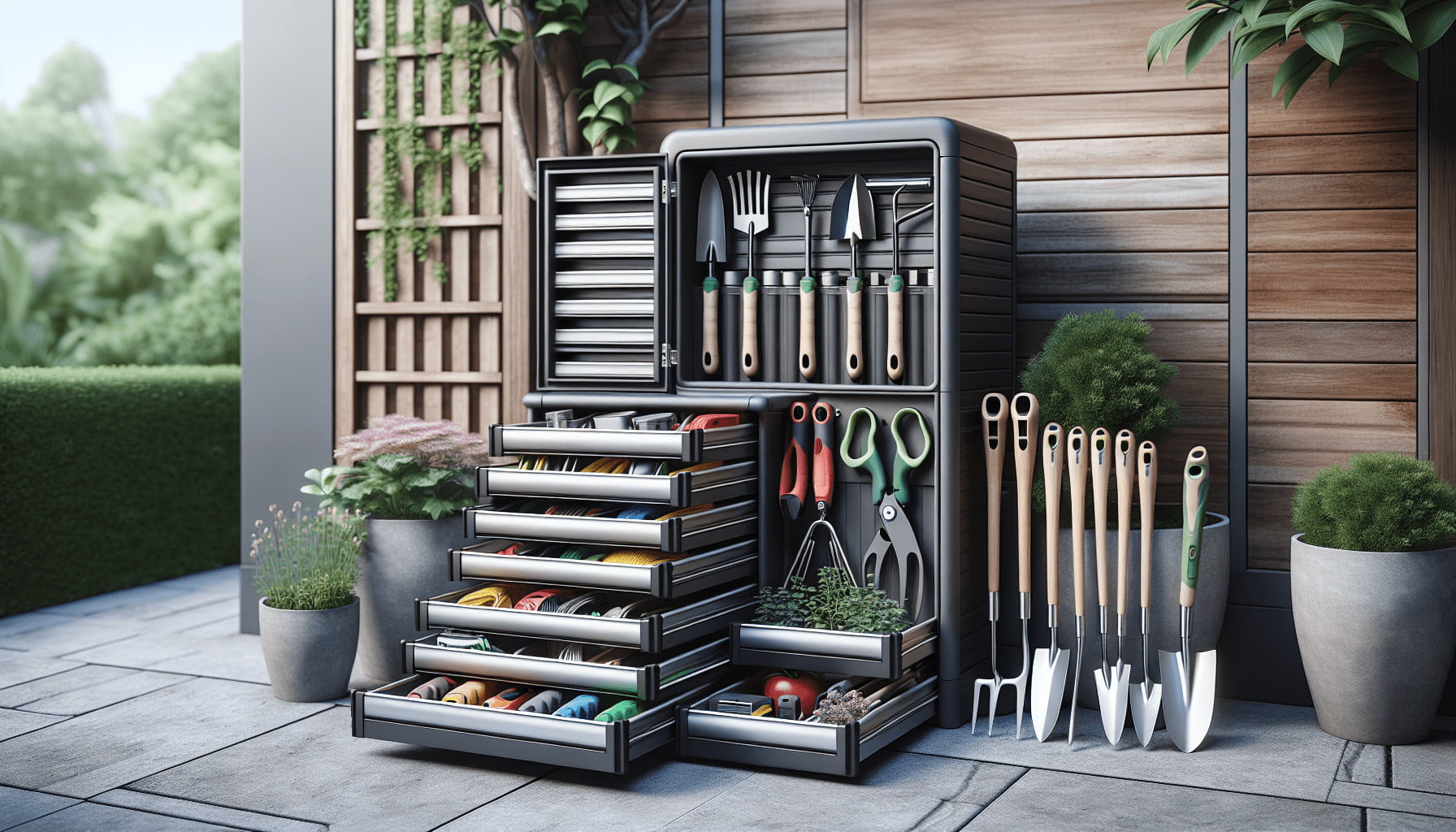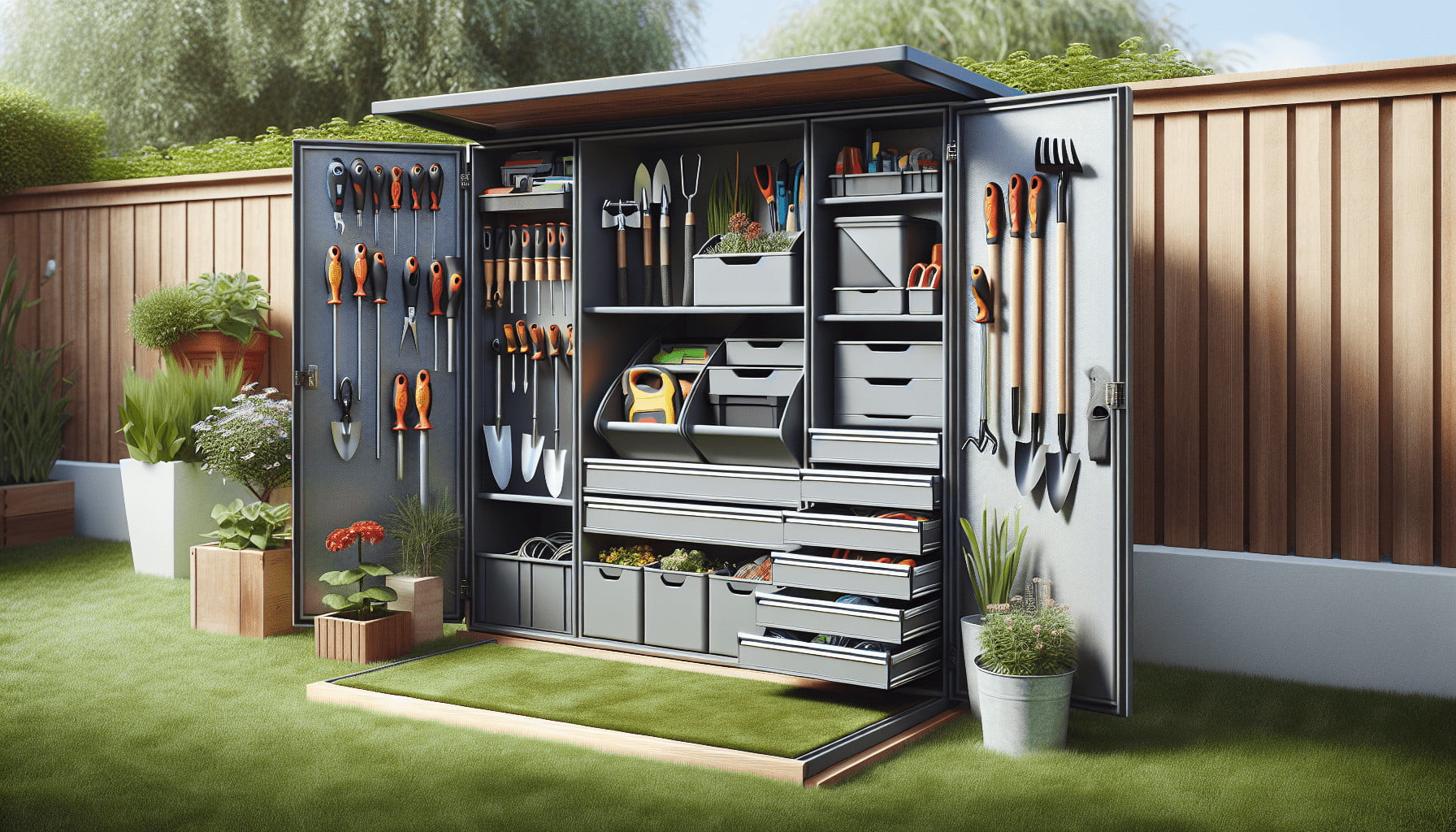Welcome to your “Ultimate Guide To Selecting The Right Tool Storage For Small Outdoor Spaces.” Whether you have a cozy balcony garden or a snug backyard, finding the right tool storage solutions can make a world of difference in maximizing your outdoor area. Imagine having a clutter-free, organized space where every tool has its place, and you can easily find what you need to keep your green oasis flourishing.
Have you ever stood in your small backyard or on your compact balcony, feeling overwhelmed by the clutter of garden tools and supplies? Having the right tool storage can transform your cozy outdoor spaces into organized, functional, and even more enjoyable areas.

Assessing Your Storage Needs
Before purchasing any storage, it’s crucial to evaluate your specific requirements.
Identifying the Tools You Own
First, take inventory of all the tools and supplies you need to store. Consider everything from larger items like shovels and rakes to smaller items like pruners, gloves, and plant ties. Make a list and note their sizes to help determine the amount of storage space required.
Frequency of Use
Think about how often you use each item. Tools you use daily should be easily accessible, while those used occasionally can be stored in less accessible areas. This can influence the type of storage unit you need, such as a freestanding unit with easy access or a more secluded bin for seasonal items.
Available Space
Measure your available outdoor space to ensure that any storage solution you choose will fit comfortably without overwhelming your area. Be sure to leave some room for maneuverability and other outdoor activities you enjoy.
Types of Tool Storage Solutions
Once you’ve assessed your needs, it’s time to explore the various storage options available. Each type of storage has its advantages and disadvantages, depending on your specific circumstances.
Wall-Mounted Storage
Wall-mounted storage solutions, such as pegboards and hooks, can be ideal for small spaces. This method allows you to utilize vertical space, keeping tools off the ground and within easy reach.
| Pros | Cons |
|---|---|
| Maximizes vertical space | Limited weight capacity |
| Keeps tools visible | Requires wall installation |
| Easy to customize | May not suit all tool types |
Freestanding Storage Units
Freestanding units can be moved around and don’t require any permanent installation. They come in various sizes and designs, from compact cabinets to larger shelves that can hold a variety of tools and supplies.
| Pros | Cons |
|---|---|
| Versatile and movable | Takes up floor space |
| No installation required | Can be bulky |
| Suitable for various tools | May need regular organization |
Storage Sheds
Although they can be larger than other options, storage sheds are useful for those with a small outdoor area but a significant amount of tools. Compact shed designs can fit into corners or against walls, optimizing available space.
| Pros | Cons |
|---|---|
| Protects tools from weather | Requires more space |
| Can hold numerous items | More expensive |
| Provides a tidy storage area | Permanent installation |
Overhead Storage
For outdoor spaces with limited ground area, overhead storage can be a useful solution. Ceiling racks and lift systems allow you to store items above your head, freeing up space below.
| Pros | Cons |
|---|---|
| Utilizes unused space | Harder to access |
| Keeps tools off the ground | Requires secure installation |
| Ideal for seasonal items | Weight limitations |
Multi-Functional Furniture
Another smart option for small spaces is multi-functional furniture that doubles as storage. Items like benches with built-in storage or tables with hidden compartments can help you save space and stay organized.
| Pros | Cons |
|---|---|
| Dual functionality | Typically limited storage |
| Space-saving | May not fit all tools |
| Aesthetic appeal | Higher cost |
Choosing the Right Material
Choosing the right material for your storage is crucial for longevity and aesthetics. Here are some common materials used in outdoor tool storage.
Plastic
Plastic storage solutions are lightweight, weather-resistant, and often more affordable. They’re ideal for small spaces as they can be easily moved around and won’t rust or rot.
Wood
Wooden storage solutions are visually appealing and can blend seamlessly into many outdoor spaces. However, they may require more maintenance, such as sealing or painting, to protect against moisture and pests.
Metal
Metal storage solutions are durable and provide a modern look. They are typically more robust than plastic, making them suitable for heavier tools. However, they can be prone to rust if not properly treated and maintained.
| Material | Pros | Cons |
|---|---|---|
| Plastic | Lightweight, Weather-resistant, Affordable | Less durable, Can look cheap |
| Wood | Aesthetic, Blend with environment | Requires maintenance, Susceptible to pests |
| Metal | Durable, Modern look | Prone to rust, Heavier |
Prioritizing Accessibility and Organization
When selecting your storage solutions, organizing your tools in an accessible manner is key to maintaining a clutter-free space.
Categorize Your Tools
Group your tools by type and frequency of use. Define specific areas for different categories like gardening tools, hand tools, and seasonal items. This way, you can quickly find the tool you need without rummaging through a cluttered area.
Easy Access for Frequently Used Tools
Tools that you use regularly should be stored in easy-to-reach areas. Consider wall-mounted hooks or shelf spaces that are at eye level. This minimizes the effort needed to access and put away these tools.
Utilize Labels
Labeling storage areas can greatly enhance organization. Simple labels can help everyone in the household know where each item belongs, reducing the chances of misplacement.
Shelving and Drawers
Incorporate shelves, drawers, and bins into your storage solution to keep smaller items organized and easily accessible. Adjustable shelves can be particularly useful as they allow you to customize storage spaces according to your needs.

Weatherproofing Your Storage
Outdoor storage needs to withstand varying weather conditions. Here’s how you can weatherproof your storage solutions.
Sealed Units
Opt for storage units with sealed doors and lids to keep water, dust, and pests out. This is especially important for wooden or metal storage that can deteriorate when exposed to the elements.
Protective Coatings
Apply protective coatings to wooden and metal storage solutions. Using water-resistant sealants on wood and rust-proof paint on metal can significantly enhance their durability.
Off-Ground Placement
Ensure that storage units are elevated above the ground. This will help prevent water damage during heavy rain and reduce the risk of pests.
Budget Considerations
It’s essential to balance quality and affordability when selecting your storage solutions. Here’s how you can stay within budget without compromising on quality.
Set a Budget
Decide how much you’re willing to spend before you start shopping. This will help you narrow down your options and prevent overspending. Remember, sometimes investing a bit more up front can save money in the long run by avoiding frequent replacements.
DIY Projects
If you’re handy, consider building your own storage solutions. DIY projects can be more cost-effective and customized to fit your exact needs and space. Online tutorials and plans are widely available for various skill levels.
Sales and Discounts
Keep an eye out for sales, discounts, and promotions. Seasonal sales, especially at the end of summer, can be a great time to purchase outdoor storage at reduced prices.
Repurpose and Upcycle
Repurposing old furniture or materials into storage can be an eco-friendly and budget-friendly solution. An old bookshelf can be converted into a storage unit, or wooden pallets can be transformed into tool racks.
Safety Considerations
Safety should be a priority when selecting and organizing your tool storage.
Securing Units
Ensure that storage units are securely anchored to prevent them from tipping over. This is especially important for tall freestanding units and overhead storage.
Lockable Storage
If you have hazardous tools or chemicals, consider lockable storage. This will help keep children and pets safe from potential dangers.
Ventilation
Adequate ventilation is crucial, especially for storage that houses chemicals or fuel-powered tools. Proper airflow can prevent the build-up of harmful fumes and reduce the risk of fire.
Eco-Friendly Options
If sustainability is important to you, there are several eco-friendly storage solutions available.
Recycled Materials
Many storage solutions are made from recycled plastic or reclaimed wood. These options reduce waste and are often just as durable as new materials.
Energy Efficient Production
Look for products that are produced using energy-efficient methods. Companies often highlight their green practices, so this information should be easy to find.
Longevity
Investing in durable, high-quality storage solutions means they won’t need to be replaced as frequently, reducing overall waste.
Personalizing Your Storage
Personalizing your storage solutions can make your space not only functional but also aesthetically pleasing.
Paint and Finish
Adding a fresh coat of paint or a decorative finish to your storage units can make them blend seamlessly with your outdoor décor. Choose colors that complement your existing setup.
Decorative Elements
Incorporate decorative elements like plants, outdoor rugs, or lighting to make your storage area visually appealing. Aesthetic touches can make a functional space feel more inviting and pleasant.
Custom Fit
Consider custom-built storage that perfectly fits the dimensions of your outdoor space. Custom solutions can maximize every inch and be tailored to your specific needs.
Conclusion
Choosing the right tool storage for small outdoor spaces might seem challenging initially, but with careful planning and thoughtful selection, you can create a clutter-free, organized, and functional outdoor area. By assessing your needs, exploring different types of storage solutions, considering the materials, prioritizing accessibility, weatherproofing, staying within budget, and ensuring safety, you can find the optimal solution tailored for your space. And remember, adding a personal touch can elevate the functionality and aesthetics of your storage, transforming your small outdoor area into an efficient and enjoyable extension of your home.
By following this guide, you’ll be well on your way to achieving a tidy, well-organized outdoor space, no matter how small. Happy organizing!
